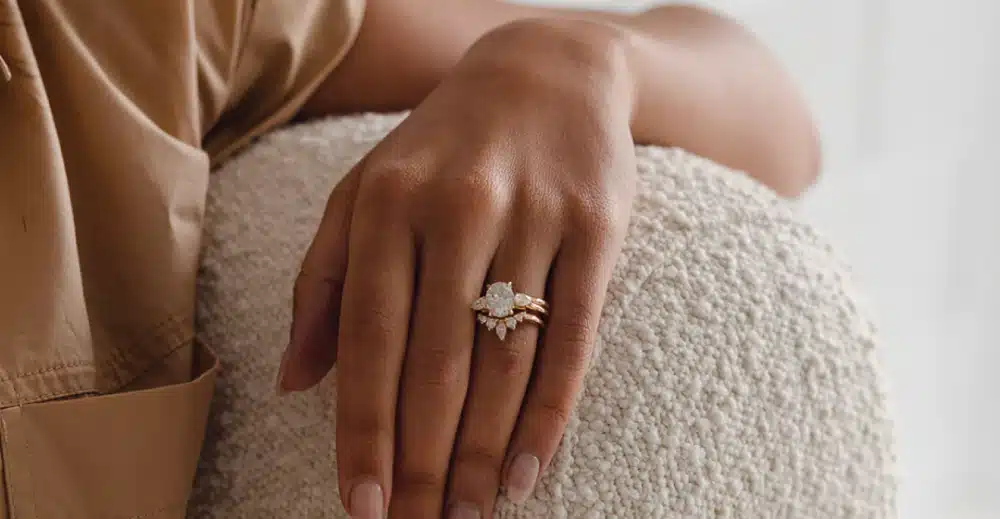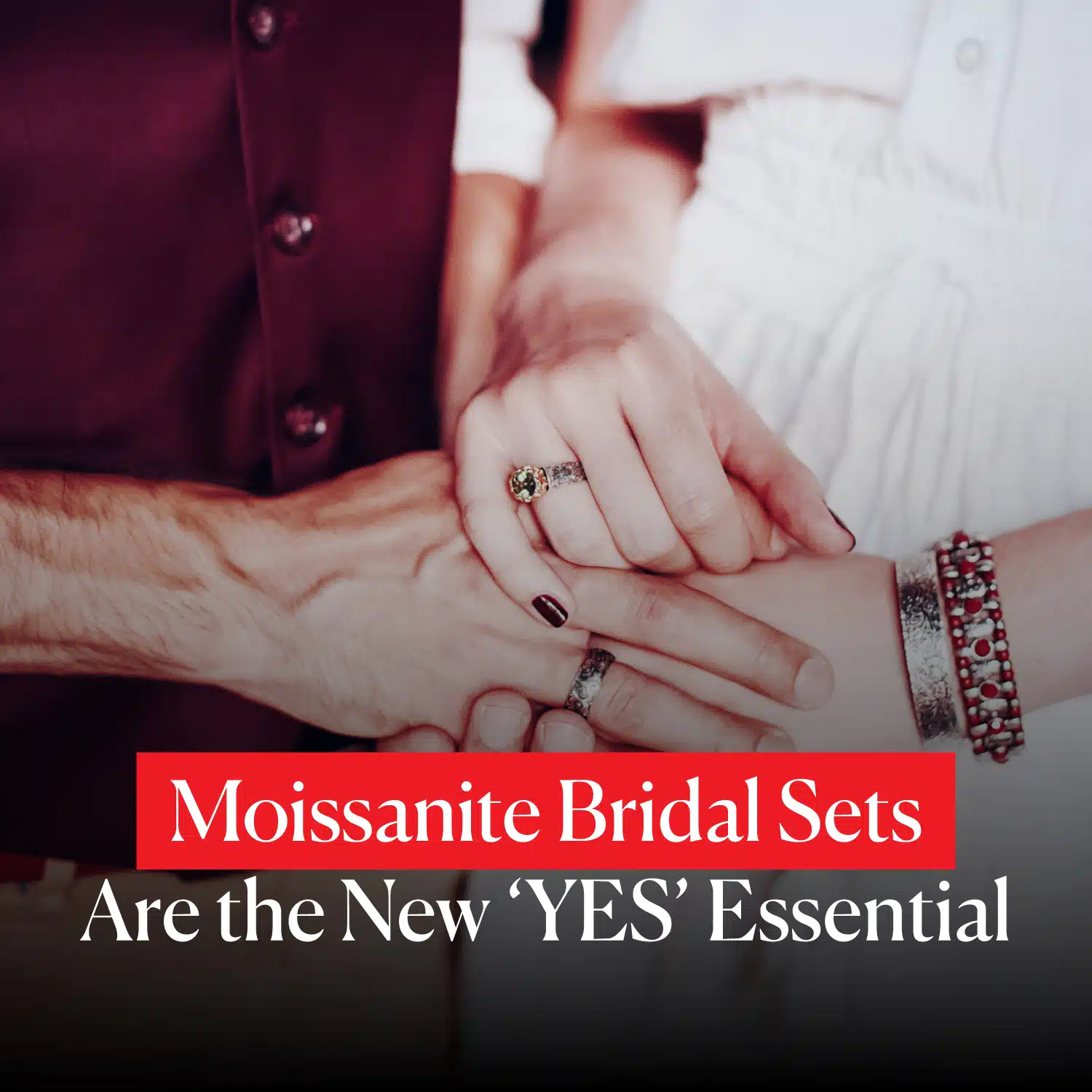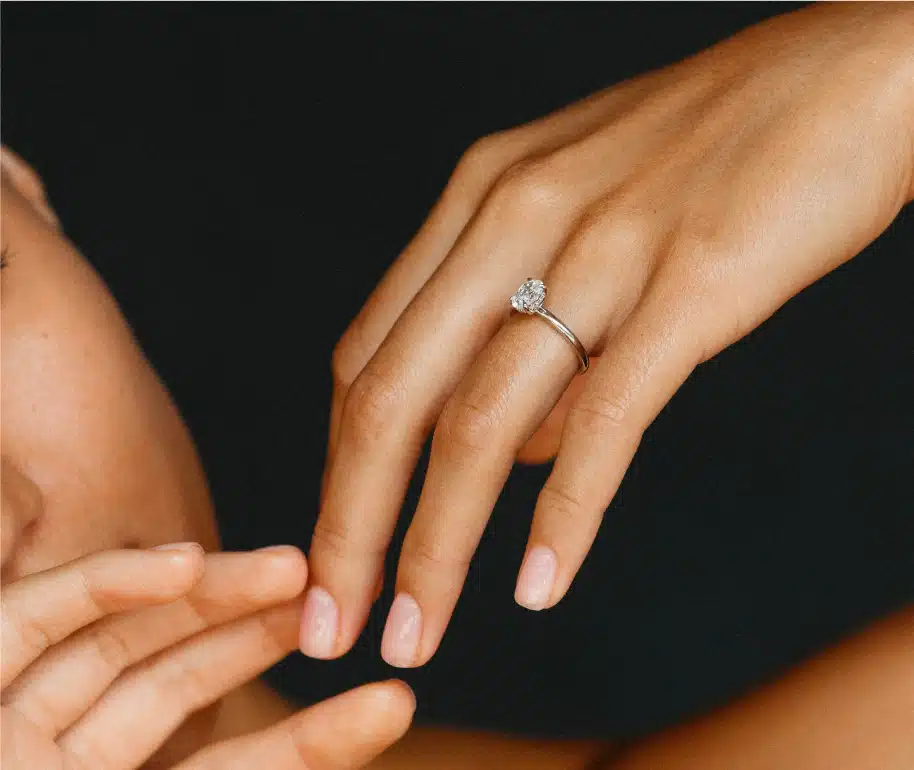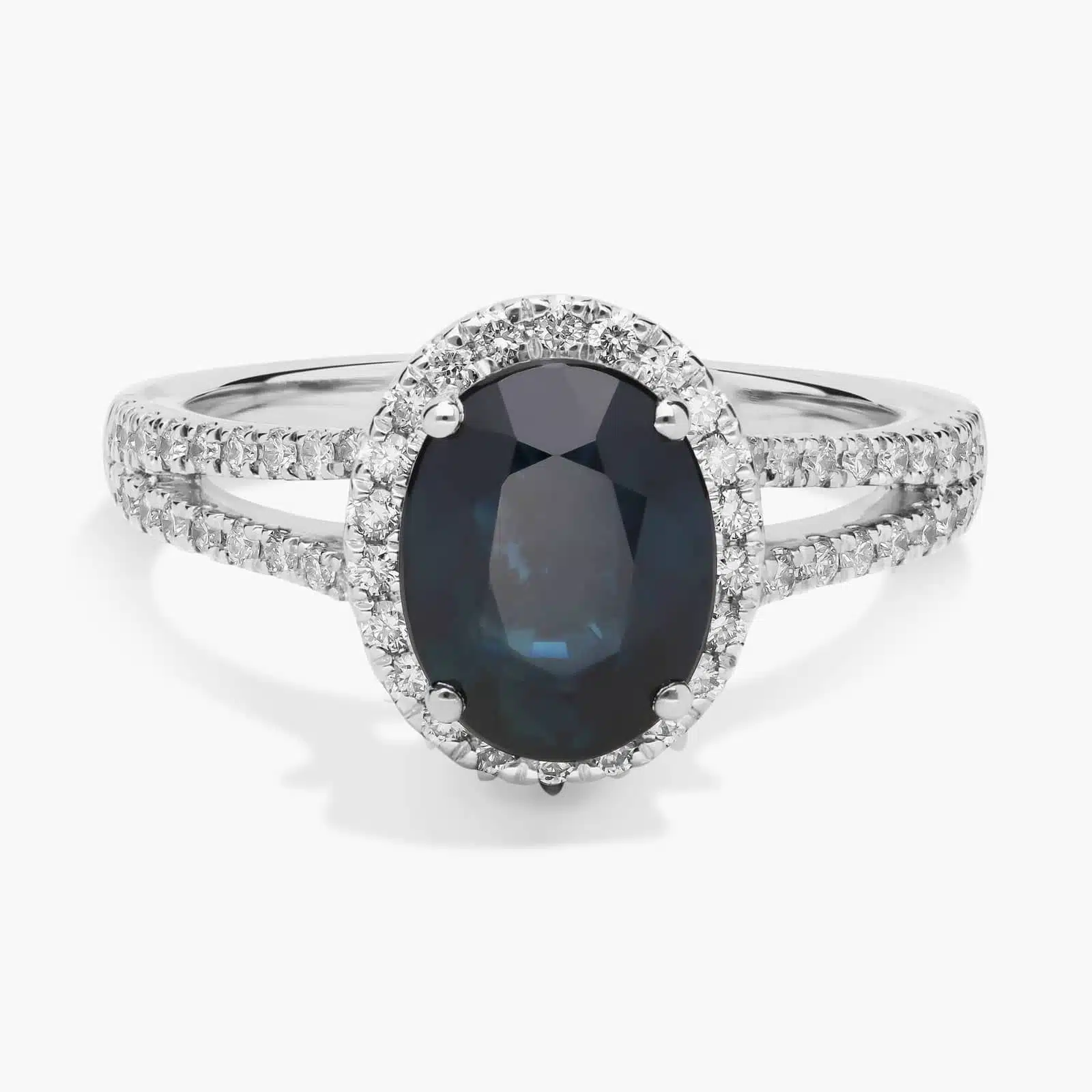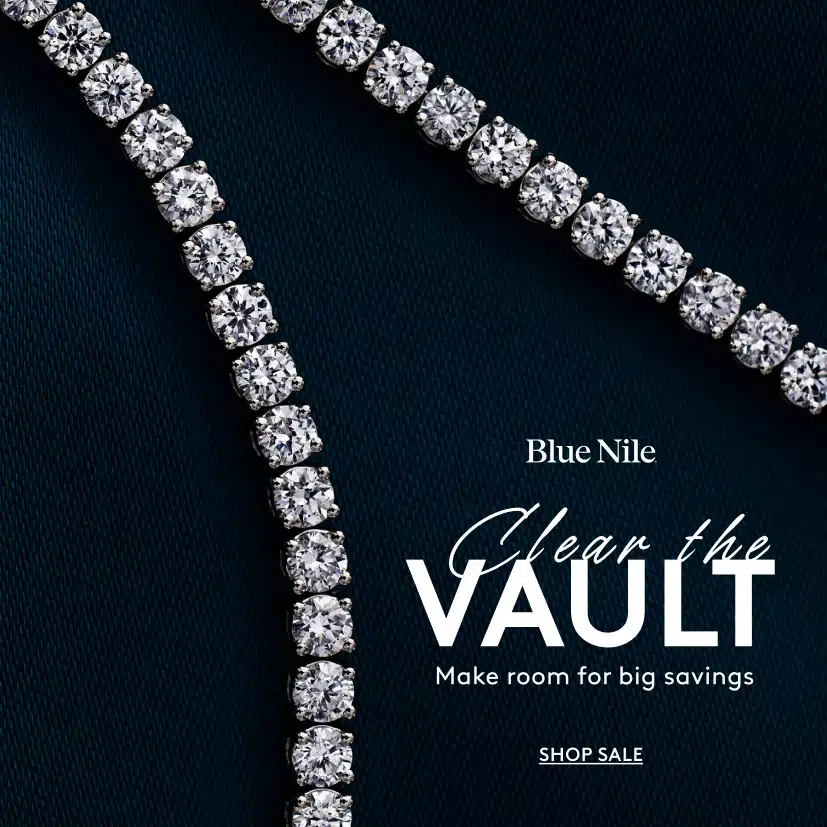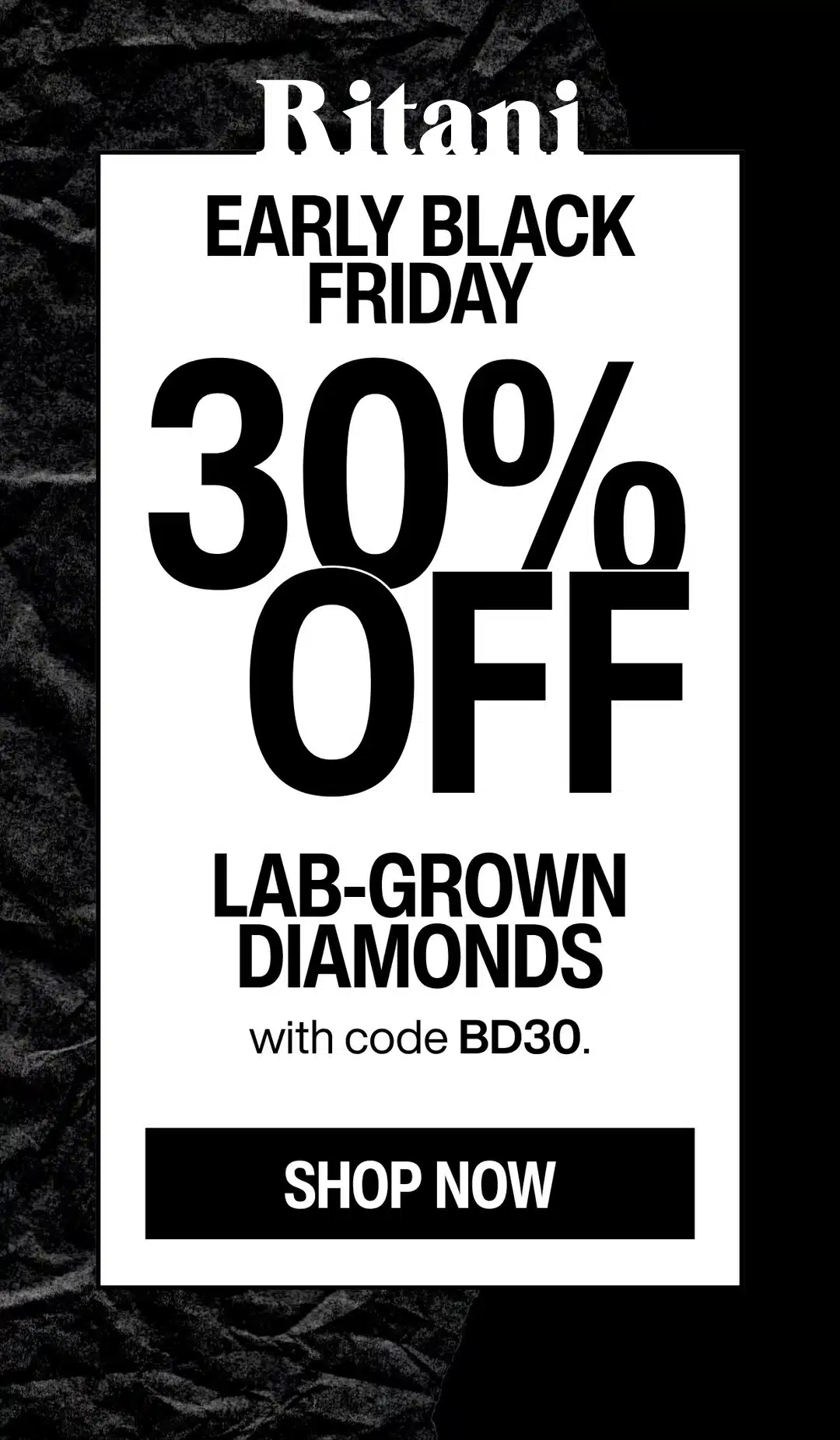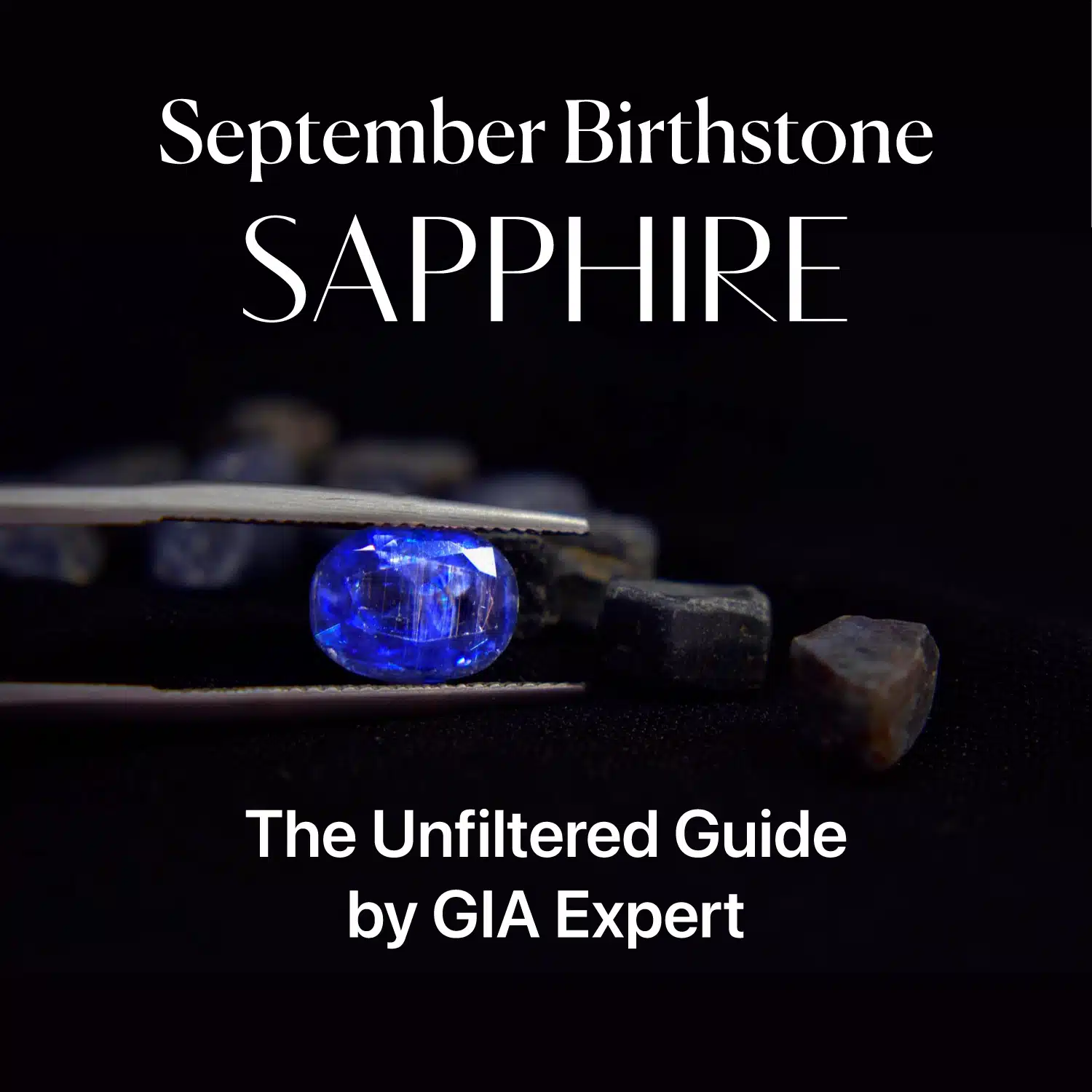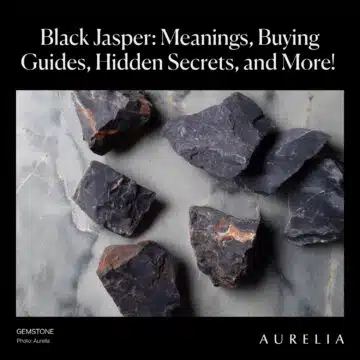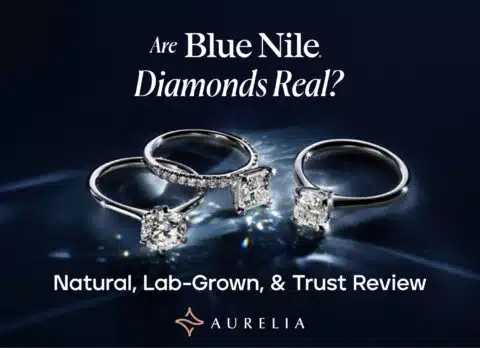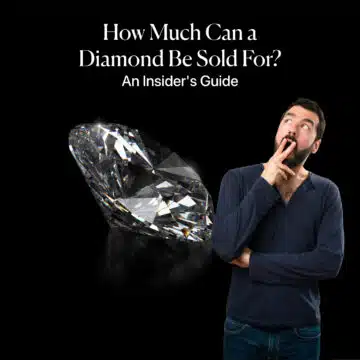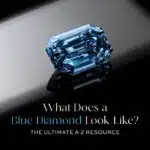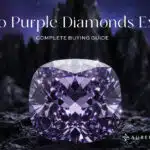When you think of the September birthstone, you probably picture one thing: a deep, velvety blue gem, the kind you see in royal crowns and priceless heirlooms. And you’re right. But that’s only a tiny part of the story.
From my time sourcing gems, I can tell you that sapphire is one of the most versatile gemstones in the world, coming in a rainbow of incredible colors—from fiery pinks and sunny yellows to rich greens and even the crystal-clear look of a fine diamond.
Believing that sapphires are only blue is the most common—and often most expensive—mistake a buyer can make.
In this guide, I’m going to give you the complete, unfiltered story. We’ll cover sapphire’s royal history and its deep spiritual meaning. Then, we’ll dive into a full expert’s buying guide, covering every color. By the end, you’ll know exactly how to shop for any kind of sapphire with total confidence.
Sapphire gemstone with a rich history and a complex personality, making it a true cornerstone of the jewelry world. Let’s get into it.
- The Sapphire Cheat Sheet: The Foundations of a September Birthstone
- What is the True Meaning of the September Birthstone?
- A Tour of the Sapphire Rainbow (They're Not All Blue!)
- The Mehedi Buying Guide: How to Buy a Sapphire Without Regrets
- Put It to the Test: My Sapphire Value Estimator
- Your Sapphire Jewelry: From Classic Gifts to Bold Statements
- Your Sapphire Questions: Answered
- Conclusion: Your Journey into the World of Sapphire
The Sapphire Cheat Sheet: The Foundations of a September Birthstone
Before we get lost in the romance of royal history and the deep spiritual meanings, let’s lay a solid foundation. If you’re seriously considering a piece of September birthstone jewelry, you need to know the core facts—the “who, what, and why” that makes sapphire one of the most treasured gems in the world.
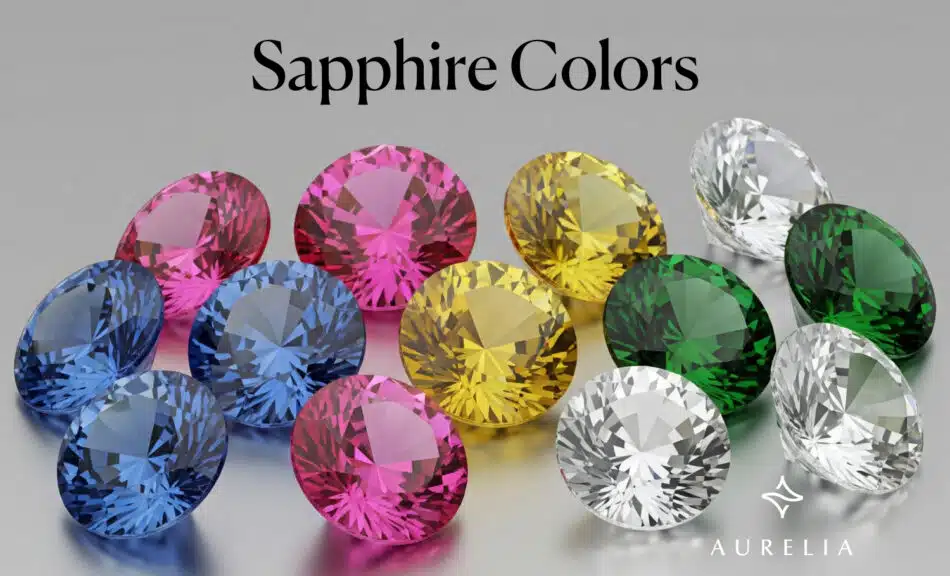
When I say sapphire, I want you to picture this—not just that iconic blue, but the entire stunning rainbow. The image above shows you the beautiful and often surprising world of the September birthstone, from fiery pinks and sunny yellows to cool greens. Understanding this variety is the first step to becoming a smart sapphire buyer.
Alright, here are the absolute basics, then we’ll dive deeper into each one.
| Attribute | Quick Fact |
| Mineral | Corundum |
| Hardness | 9 (Mohs Scale) |
| Primary Color | Blue |
| Color Range | Every color except Red |
| Anniversary | 5th and 45th |
Now, let’s talk about what those quick facts really mean for you and your wallet.
Its Family Tree: A Ruby in Disguise
Sapphire’s mineral name is corundum, which might sound technical, but it’s the key to everything. Corundum is a crystal made of aluminum oxide. In its purest, natural state, it is completely colorless (what we know as a white sapphire).
But here’s the magic: when tiny traces of other elements get mixed in during its formation, corundum transforms into a rainbow of different colors. If traces of chromium are present, you get a fiery red gem—a Ruby.
If traces of iron and titanium are present, you get that deep, velvety blue sapphire, which is the most famous color for the September birthstone. It’s all the same family. Every sapphire is, essentially, a ruby of a different color, and it’s what a sapphire is made of that gives it its identity.
Its Strength: Built for a Lifetime
A gemstone’s hardness is its resistance to being scratched, and at a 9 on the Mohs scale, sapphire is an absolute tank. It is second only to diamond (which is a 10) and moissanite in terms of durability.
Why this matters to you: This is not a fragile, “special occasions only” gem. This is one of the toughest precious stones on the planet. This durability is the reason why a sapphire September birthstone ring is one of the best and most popular choices for an engagement ring.
It’s built to withstand the bumps and scrapes of everyday life for generations, making it a purchase you can make with total confidence.
Its Colors: More Than Just Blue
So, what color is a September birthstone? While that classic blue is the primary color associated with the birthstone of September, it’s far from the only one.
Since a “ruby” is technically a red sapphire, the september stone birthstone can be any other color on the spectrum. You’ll find a stunning array of fancy sapphires:
- Pink Sapphires: A beautifully romantic and popular choice.
- Yellow Sapphires: Bright, sunny, and often more affordable.
- Green Sapphires: A unique, earthy, and sophisticated option.
- Padparadscha Sapphires: The rarest and most valuable of all, with a perfect pinkish-orange “lotus blossom” color.
- White Sapphires: A natural and highly durable alternative to a diamond.
The sheer variety of September birthstone color options is one of the things that makes sapphire such a special and personal gem.
Its Legacy: A Symbol of Love and Loyalty
While we’ll dive deeper into the history in the next section, you should know that sapphire is the traditional gift for two major wedding anniversaries: the 5th and the 45th. The choice is intentional. For centuries, the September birthstone meaning has been tied to faithfulness, sincerity, and truth.
Giving sapphire is a powerful way to honor a long-term commitment and reaffirm the loyalty in a relationship. Whether it’s in a september birthstone necklace for a new partner or a september birthstone ring for a long-time spouse, the message is clear and timeless.
What is the True Meaning of the September Birthstone?
A gem that has been revered for thousands of years carries more than just beauty; it carries the weight of history, belief, and countless human stories.
The birthstone for September is no exception. Its meaning runs deep, touching on everything from royal power to spiritual clarity. Let’s look at the true story behind this incredible gem.
A Legacy of Wisdom, Royalty, and Protection
Long before a sapphire was simply a piece of September birthstone jewellery, it was a powerful talisman. The very name “sapphire” is believed to come from the ancient Greek word for blue, sappheiros, and for centuries, people believed this gem held the power of the heavens.
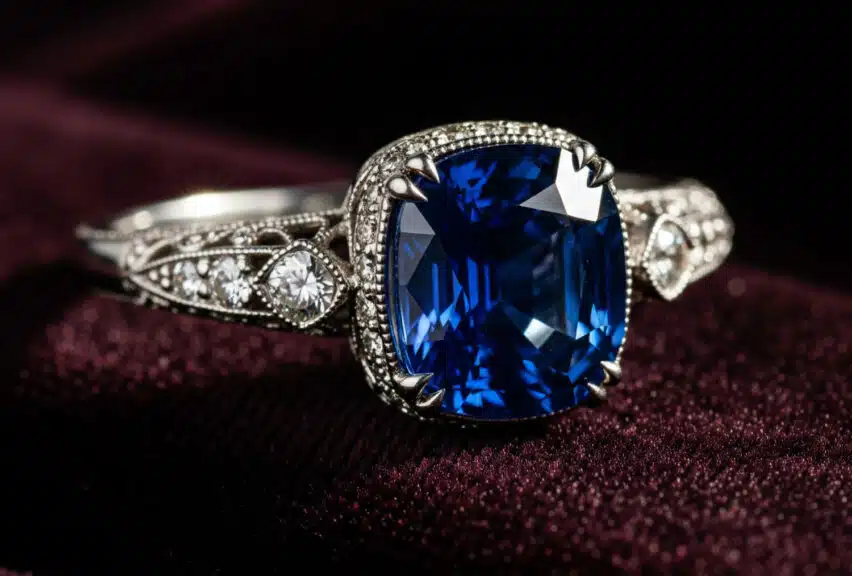
Ancient Persians thought the world rested on a giant sapphire, which painted the sky blue with its reflection.
Because of this celestial connection, the birthstone of September has always been a stone of the wise and the powerful. Kings and rulers wore sapphires not just as a symbol of their wealth, but as a form of divine protection.
They believed the gem would shield them from harm and envy. High priests and clergy in the Middle Ages wore sapphires as a symbol of heaven, believing it fostered spiritual clarity and kept their thoughts pure.
This is the historic core of the september birthstone meaning:
- Wisdom & Truth: A belief that it clears the mind and allows the wearer to see the truth.
- Protection: A talisman to guard against evil and misfortune.
- Faithfulness & Sincerity: Its steady, celestial blue made it the ultimate symbol of trust and loyalty, making the sapphire september birthstone a treasured gift between lovers.
For Virgos (and Libras!): The Zodiac Connection
September is a month shared by two zodiac signs, and the sapphire’s energy speaks beautifully to both.
For those born under Virgo (up to September 22nd), the sapphire is a perfect match. The birthstone for virgo september is seen as a stone that enhances clarity of thought, focus, and integrity—all cornerstone traits of the analytical and sincere Virgo.
I think of it as a tool that helps a Virgo’s brilliant mind cut through the noise and focus on what truly matters.
For those whose birthday falls under Libra (September 23rd onward), the sapphire is a powerful symbol of balance and partnership.
As the birthstone of September 23, it resonates with Libra’s innate sense of justice, truth, and harmony. Its association with sincerity and faithfulness makes it a perfect stone to strengthen the bonds in a Libra’s life.
A Stone for the Mind and Spirit: The Chakra Connection
If you’re interested in the spiritual side of gemstones, sapphire has a powerful connection to the energy centers of the body. Its energy is most closely tied to two specific chakras:
- The Throat Chakra: This is your center of truth and communication. Wearing a sapphire is thought to help you find the right words, speak with clarity and confidence, and express yourself authentically.
- The Third Eye Chakra: Located in the center of the forehead, this is your seat of intuition and inner wisdom. Sapphire is believed to stimulate this chakra, helping to quiet mental chatter and allow you to see a situation clearly, with greater perspective.
Think of sapphire as a tool for clear communication and intuition. Whether you’re a believer in chakra energy or not, the symbolic meaning is the same: the birthstone for the month of September is a gem that is believed to focus the mind and calm the spirit.
A Tour of the Sapphire Rainbow (They’re Not All Blue!)
This is where the real fun begins, and where I’m going to let you in on the biggest secret of the September birthstone. I want you to completely forget the idea that the color of the September birthstone is only blue.
While that classic hue is the undisputed king, the birthstone sapphire is a master of disguise, appearing in a breathtaking spectrum of colors. Understanding this variety is what separates a novice buyer from an expert. Let’s take a proper tour of the sapphire rainbow.
The Icon: Classic Blue Sapphire
This is the legend, the color of royalty and romance. The what color birthstone is september question almost always defaults to this iconic blue. For thousands of years, this is the gem that people have revered.
When gemologists talk about the absolute finest blues, they often refer to two legendary benchmarks that you’ll hear in the trade:
- Kashmir Blue: The rarest and most sought-after. It’s a deep, rich, velvety blue with a very slight violetish tint. The most magical quality of a Kashmir sapphire is that it maintains its vibrant color even in low, artificial light, a phenomenon often described as having a “sleepy” or glowing quality.
- Cornflower Blue: A vibrant, lively, and highly saturated blue. It’s a slightly lighter and more brilliant shade than Kashmir, reminiscent of the bright flower. It’s a spectacular and highly valuable color in its own right.
A fine blue sapphire should be richly saturated, but not so dark that it appears inky or black in dim lighting. You are paying for the richness of that blue hue. It is the king of all sapphires for a reason.
| Blue Sapphire | The Straight Scoop |
| Meaning | Wisdom, Loyalty, Faithfulness |
| Price Point | Highest of all sapphire colors |
| Best For | The timeless, traditionalist buyer |
The Rising Star: Pink & The Legendary Padparadscha
In recent years, the popularity of pink sapphires has absolutely exploded, especially for engagement rings. And with good reason! They offer a wonderfully romantic and feminine alternative to a pink diamond, but with a durability that makes them just as suitable for a ring you will wear every day.
The color spectrum is mesmerizing, from a soft, delicate pastel or “baby pink” all the way to an intense, vibrant hot pink that can be electrifying.
Living within this rosy family is a true legend of the gem world: the Padparadscha sapphire. The name comes from the Sinhalese word for “lotus blossom,” and that is the perfect description.
A true Padparadscha has a one-of-a-kind, breathtaking pinkish-orange color that gem dealers have romanticized for centuries. It is exceptionally rare, and fine specimens are among the most valuable gemstones on Earth, a true collector’s dream.
| Pink Sapphire | The Straight Scoop |
| Meaning | Love, Good Fortune, Passion |
| Price Point | High, especially for intense shades. Padparadscha is in a class of its own. |
| Best For | The romantic, modern buyer who wants a unique look. |
The rising popularity means pink sapphire prices are strong, but they still offer a huge value compared to a pink diamond. The legendary Padparadscha is a treasure you may never see, but its story elevates the entire pink sapphire family.
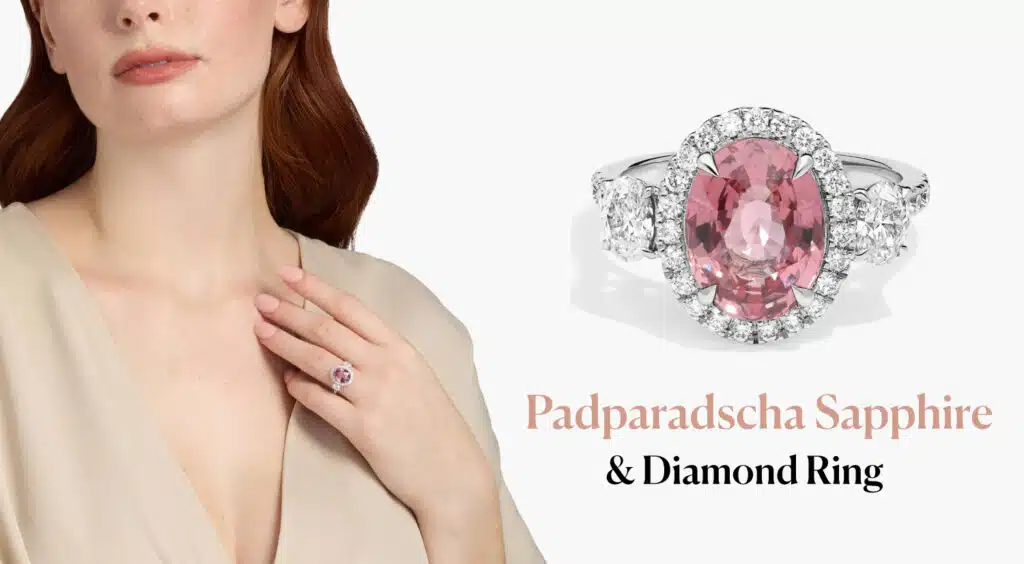
The Sunshine & The Forest: Yellow & Green Sapphires
These are what I call the “savvy shopper’s sapphires.” I absolutely love them because they offer vibrant, unique colors, often at a much more accessible price point than their blue and pink siblings. This makes them a fantastic choice for a stunning piece of September birthstone jewelry that truly stands out.
A fine yellow sapphire is pure joy. Its color can range from a light, lemony pastel to a deep, rich, canary or golden-yellow. A well-cut yellow sapphire is incredibly brilliant and has a sunny disposition that’s impossible to ignore.
Green sapphires are their more earthy, sophisticated cousins. The color range here is vast, from a light mint green to a deep forest or olive green. They don’t have the fiery “glow” of a top emerald, but what they offer is a rich, unique color with far superior durability and often a cleaner appearance.
| Yellow & Green Sapphires | The Straight Scoop |
| Meaning | Prosperity & Wisdom (Yellow), Faith & Integrity (Green) |
| Price Point | Very Accessible to Moderate |
| Best For | The savvy buyer who values individuality and excellent value. |
Don’t sleep on these gems. For the price of a small blue or pink sapphire, you can often get a much larger and equally beautiful yellow or green sapphire. They are the definition of a smart luxury purchase.
The Insider’s Choice: White Sapphire
Here’s the secret weapon that many people miss. What color is September’s birthstone if you want the look of a diamond without the astronomical price tag? It’s a white sapphire. In its purest form, corundum is completely colorless, and a top-quality, well-cut white sapphire is a stunningly beautiful gemstone.
Its most important feature is its durability. At a 9 on the Mohs scale, it shares the same toughness as its colored sapphire siblings, making it a truly outstanding and practical choice for an engagement ring. While it doesn’t have the same fiery dispersion (the rainbow flashes) as a diamond, it has its own beautiful and distinct, bright, icy brilliance.
| White Sapphire | The Straight Scoop |
| Meaning | Purity, Clarity, New Beginnings |
| Price Point | Most accessible of all sapphire colors |
| Best For | The practical buyer looking for a durable, natural diamond alternative. |
When clients come to me asking for a natural, durable, and affordable diamond alternative, a white sapphire is always at the very top of my recommendation list. It’s the ultimate diamond alternative.
Sapphire Colors: The Head-to-Head Comparison
| Color | Vibe | Price | Durability |
| Blue | Timeless, Royal | Highest | 9 |
| Pink | Romantic, Modern | High | 9 |
| Padparadscha | Ultra-Rare, Collector | Elite | 9 |
| Yellow | Sunny, Joyful | Accessible | 9 |
| Green | Earthy, Sophisticated | Accessible | 9 |
| White | Icy, Classic | Most Accessible | 9 |
The Mehedi Buying Guide: How to Buy a Sapphire Without Regrets
Alright, let’s get down to business. This is the most important part of our conversation. You’ve seen the colors, you know the history. Now, how do you actually buy a sapphire birthstone and know you’re getting a great value for your money?
When I worked on the supply side, I saw what separated a good sapphire from a great one—and it wasn’t always what people expected. Forget what you learned about diamonds for a moment. With colored gemstones like sapphire, the rules are different. Let’s walk through my personal checklist.
The #1 Rule: It’s All About COLOR
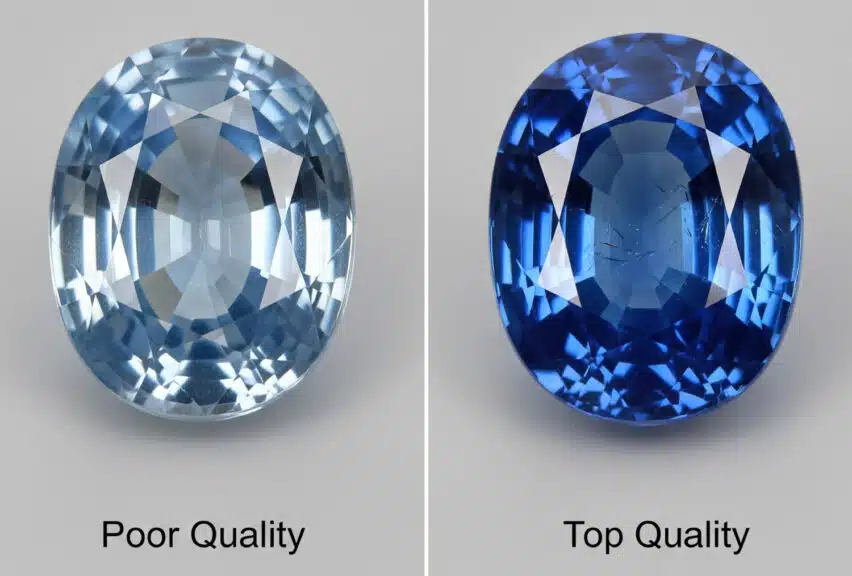
This image is a perfect lesson. The sapphire on the left is technically “cleaner” on the inside, with fewer inclusions. But look at its color—it’s pale, watery, and lifeless. The sapphire on the right has a few tiny internal birthmarks, but its color is absolutely spectacular. It’s rich, vibrant, and electrifying.
Which one do you think is worth more? It’s the one on the right, and it’s not even close.
This is the most common mistake I see people make. They get so focused on a stone being “flawless” that they forget to pay attention to the one thing that gives a sapphire its soul. A rich, beautiful color will always trump a pale, clean one. This is the first and most important secret to finding a truly spectacular sapphire gemstone.
If you remember only one thing from this guide, make it this: with a sapphire, color is king.
In the world of diamonds, a tiny internal flaw can tank the value of a stone. But for sapphires, clarity takes a backseat to the quality of the color. It’s a complete reversal of priorities.
Think of it like buying a painting. Would you rather have a masterpiece with vibrant, rich colors that had a tiny, invisible speck of dust on it, or a perfectly clean canvas with washed-out, pale, and lifeless colors? The choice is obvious.
It’s the same for a sapphire. A vibrant, richly saturated sapphire with a few minor inclusions you’d never see without a loupe is infinitely more valuable and beautiful than a technically “flawless” sapphire with a weak, watery color.
The color—its saturation (intensity) and its tone (lightness or darkness)—is what gives the gem its life, its personality, and its value. It’s the source of a sapphire’s beautiful luster and brilliance.
The Critical Question: “Is This Sapphire Heated?”
This is the question that separates an informed buyer from a novice. You absolutely must ask it, but the answer isn’t as scary as it sounds.
Let me be very clear: the vast majority of sapphires on the market—well over 95%—are heated. This is a standard, stable, and completely accepted practice in the gem trade. It’s not a dirty secret; it’s the final step of the finishing process.
Gentle heating is what dissolves microscopic inclusions and unlocks the stone’s full color potential, transforming a hazy, less saturated gem into a brilliant, transparent beauty. It’s a permanent treatment that requires no special care.
An unheated sapphire with top-tier color and clarity is exceptionally rare, and it commands a massive price premium to match. An unheated blue sapphire is the choice for the purist or the investor, as is a top-quality, untreated unheated pink Umbra sapphire. For most buyers, a heated sapphire offers a much more beautiful stone for a significantly better price.
Natural vs. Lab-Created: The Ultimate Value Question
This is the biggest value decision you’ll make. A lab-created sapphire is not a fake; it is a real sapphire with the exact same chemical and physical properties as a mined one. The only difference is its origin. I call this the choice between Legacy vs. Logic.
| Factor | Natural Sapphire | Lab-Created Sapphire |
| The Story | A billion-year-old treasure from the Earth. | A marvel of modern science. |
| Appearance | May have natural inclusions (“birthmarks”). | Often visually flawless and top-color. |
| The Price | Significantly higher due to rarity. | A small fraction of the natural price. |
| The Verdict | You’re paying for rarity and a piece of history. | You’re paying for perfection and accessibility. |
There’s no wrong answer here, only the right answer for you. If you value the romance of a gem that’s billions of years old, choose natural. If you want the most visually spectacular sapphire you can get for your budget, a lab-created stone is a brilliant choice.
This is one of the most important decisions, so take your time to understand the differences between a lab-created sapphire vs a real sapphire.
Understanding Sapphire’s Price Tag
So, how much should a ring with a september birthstone cost? The value of a sapphire is a complex formula based on all the factors we’ve discussed. Unlike gold, there is no simple spot price. The final sapphire prices are determined by a combination of:
- Color Quality: This is the most important factor. Rich, vibrant saturation commands the highest prices.
- Carat Weight: A sapphire’s weight is just one part of its value story. Learn more here.
- Clarity: An eye-clean stone with minimal visible inclusions is the standard.
- Cut: A well-cut stone will be brilliant and lively. A poor cut will look dead.
- Origin: A sapphire from a famed historical source like Kashmir or Burma can carry a premium.
- Treatment: Whether the stone is heated or unheated makes a massive difference in the final cost.
The interaction of all these factors is what determines a sapphire’s value per carat, making each gem a unique proposition.
Put It to the Test: My Sapphire Value Estimator
Alright, we’ve talked a lot about what makes a September birthstone valuable—from the richness of its color to its carat weight. But what does that actually look like on a price tag?
To help you demystify the numbers, I’ve brought over my Sapphire Value Estimator tool. This isn’t just a random number generator. It’s a smart tool that gives you a solid ballpark estimate based on the real-world pricing of high-quality sapphires from our most trusted retailers, Blue Nile and James Allen.
It’s simple to use. Just plug in the sapphire color you love and the carat weight you’re considering. The tool will give you an instant, realistic idea of the current market value for sapphires with good color and clarity.
Once you have your estimate, the real fun begins. The button that appears will let you take your new knowledge and explore live, in-stock options from the retailers themselves. It’s the best way to turn a price estimate into your perfect piece of sapphire jewelry.
Sapphire Value Estimator
Your Sapphire Jewelry: From Classic Gifts to Bold Statements
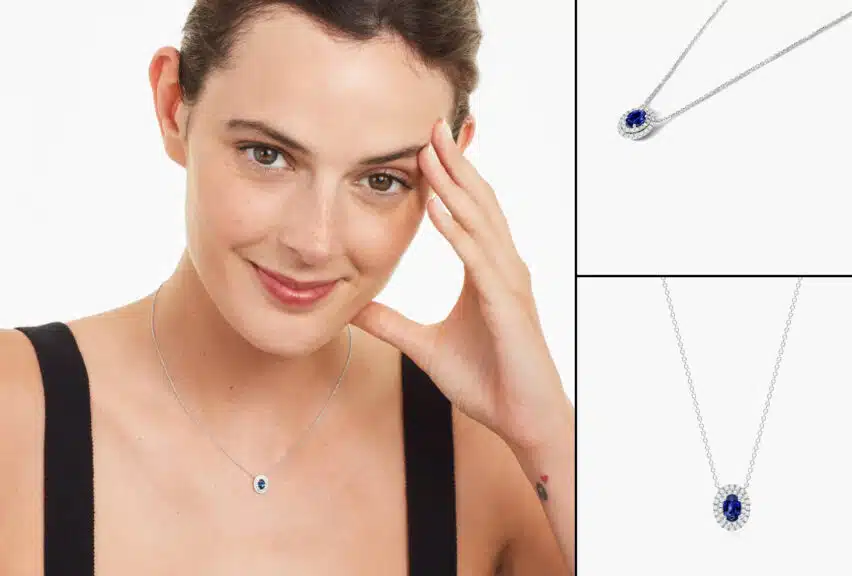
It’s a can’t-go-wrong, classic piece of september birthstone jewellery that is always in style, perfect for a birthday, an anniversary, or any special occasion. This is the kind of gift that shows real thoughtfulness and impeccable taste. When you want to give a piece of sapphire jewelry that feels both personal and luxurious, a pendant like this is always the right answer.
Alright, you’re practically a sapphire expert now. You know what to look for, the right questions to ask, and how to spot a great value. So, how do you put that knowledge into action? Let’s talk about the beautiful jewelry that makes the September birthstone so beloved.
For a birthday, especially a milestone one like a September 18th birthstone or a September 25th birthstone, you can never go wrong with a timeless, classic gift. I always recommend two pieces:
- Sapphire Stud Earrings: A pair of simple, elegant sapphire studs is a piece of jewelry they can wear every single day. It’s a constant, beautiful reminder of their special month.
- A Solitaire Pendant: A single, beautifully-cut sapphire on a delicate chain is the definition of understated luxury. A september birthstone necklace is a personal, classic choice that is always in style.
The Ultimate Engagement Ring
Beyond birthdays, the september birthstone ring has become one of the most popular choices for engagement rings—and for good reason. Its durability, at a 9 on the Mohs scale, means it’s one of the few colored gemstones I can confidently recommend for the daily wear of an engagement ring.
From the iconic blue sapphire ring that Princess Diana wore (and Kate Middleton now wears) to the rising trend of pink, yellow, and white sapphire solitaires, it offers a way to have a unique, personal, and colorful ring without sacrificing any of the heirloom quality or toughness you expect from a lifelong piece.
Whether you’re looking for a birthday gift for someone special or a timeless piece for yourself, the best way to apply all of your new knowledge is to see it in action. Explore a curated collection of fine sapphire jewelry, look at the different colors, and see which one speaks to you. You’re no longer just browsing; you’re shopping like an insider.
Your Sapphire Questions: Answered
So, the September birthstone is far more than just a simple blue gem. It’s a rainbow of color, a symbol of wisdom, and a durable, beautiful choice for any piece of jewelry. Now that you know what to look for—from focusing on color to always asking about treatments—you can shop for one like a true insider.
When you’re ready to make a choice, a few questions always come up. Here are my direct, no-nonsense answers to the most common ones I hear.
Conclusion: Your Journey into the World of Sapphire
And there you have it. The full, unfiltered story behind the magnificent September birthstone. It’s so much more than just a simple blue gem, isn’t it? It’s a rainbow of brilliant color, a symbol of wisdom and royalty, and one of the toughest, most durable gemstones you can own.
But more importantly, you now have the insider’s toolkit. You know that with sapphire, Color is King. You know to ask the critical question about heat treatment and that it’s a standard, safe practice. You know that a flawless clarity grade isn’t nearly as important as the life and vibrancy of the gem itself.
So whether you’re shopping for a classic blue September birthstone necklace for a loved one, or choosing a bold pink or yellow sapphire for yourself, you’re no longer just browsing. You’re shopping with confidence.
You know what to look for. You know the right questions to ask. Go find something beautiful that tells your story.
Here are some additional birthstone guides to explore:


